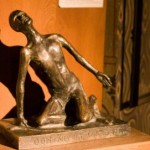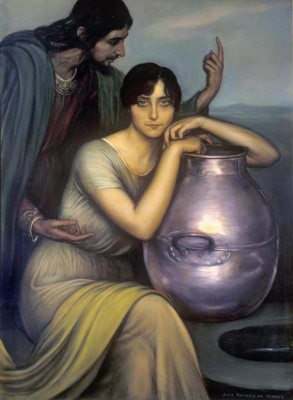 “How is it that you ask a drink of me?”
“How is it that you ask a drink of me?”
John tells this story: Jesus is preaching among the Samaritans, in their land, north of Judea and south of Galilee.
He has walked a long way. It’s noon, it’s hot and he’s thirsty. He stops at Jacob’s well, an ancient sacred spot and a public well. He has no cup. And he asks a Samaritan woman to give him a drink.
She is justly suspicious. He’s alone and so is she. His sort doesn’t make small talk with her sort, let alone drink from her cup. And she’s knows she is alluring, she’s lived with five men already and her current bedfellow is married to someone else. What is this Galilean up to, anyway, she wants to know. Jesus knows all this about her, and tells her so. And then he offers her the first Cup of Eternal Life.
This is no chance encounter. This Cup is nowhere more precious than it is in the gospel of John, whose careful writer would never have Jesus idly hand off something so sacred to a passing woman. Nor would John, who has constructed his book symbolically, using signs and wonders, include anything offhand or by chance.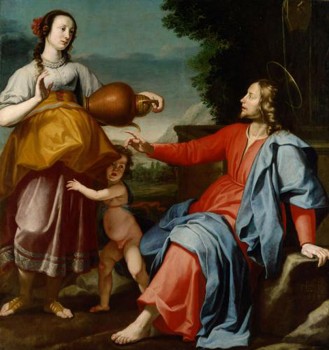
According to John, this Cup, the Grail Cup, is first given not to the men who are named as disciples, not to Galileans and not to Temple Jews, but to a woman of tarnished repute, a daring woman and a Samaritan at that.
Samaritans did not read the prophets, but the other gospels attribute many a saying or deed of the prophets as proof of Jesus’ holiness, over the years. The one prophet never mentioned is Hosea, who dearly loved and married a prostitute, Gomer, who ran off and had sex with another man, then came back home when Hosea sought her. Their marriage, by the custom of the time, was arranged between Hosea and Gomer’s father, and was not the result of wooing. He was older than she. There were children, a daughter, named Not Pitied, and a son, Not My People. Hosea’s love for Gomer was deep, and his forgiveness endless, and at last she did return his love, and as a sign, the names of the children were changed. Some see Hosea’s marriage as an allegory of the love between God and Israel, a people tempted to love many false idols.
![]() Is John drawing a picture of Jesus as Hosea here, and telling us the same truth about God’s deep love, and in particular about the Cup we share? Is the woman at the well Jesus’ Gomer, and by extension, all of us?
Is John drawing a picture of Jesus as Hosea here, and telling us the same truth about God’s deep love, and in particular about the Cup we share? Is the woman at the well Jesus’ Gomer, and by extension, all of us?
Does she receive the first Cup of Life to show that it is not a trickle-down cup given by the virtuous, or by ecclesiastical higher-ups, or by those who love Jesus more, to the abashed rest of us? Pope Francis said recently that the eucharist is not a reward for good behavior, but given to us for healing. Surely this story in John, and the placement of this first Cup in the hand of this woman, is substantive proof of Pope Francis’ teaching.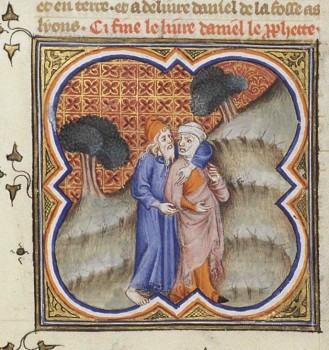
Jesus does not reprove her. We know this, because in her excitement she runs into town and tells everyone to come and see this man who knew all about her life. No one, having been reproached, would rush off in glee to spread the news of a scolding around town. She has been set free from all shame by Jesus’ acceptance.
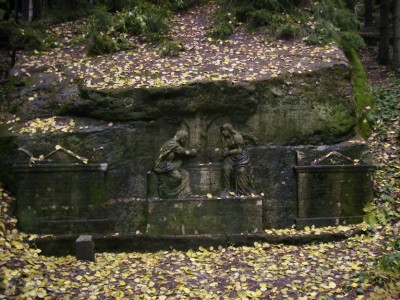 The story does not stand alone. There are many tales of Jesus’ affirmation for women who are seen as unrighteous by others.
The story does not stand alone. There are many tales of Jesus’ affirmation for women who are seen as unrighteous by others.
And there are no tales of Jesus praising marriage, virginity, or family life. It may be that he values in this woman that she, like Gomer, longed to love and be loved, and would not settle for less. Jesus found a way to reach her spirit, through the integrity of her desire.
Family is a far, far, older tradition than Jesus, one that has evolved and is still evolving in its customs, and in its culturally attributed virtues and taboos. In many cultures virginity still has monetary value, and that value does not belong to the virgin, but to her elders. That value transfers to her husband, who pays a bride price for her, and then to her son, whose sonship comes from her. Jesus’ blessing and friendship are continually given to women who no longer have value, as virgins, as wives, or as mothers. These are women no one ‘owns.’ Their vulnerability appeals to him, where propriety, in neither men nor women, elicits any tenderness from him. The woman at the well, who belongs to no one, is free to give herself to God.
 How does the church, which has for so long insisted that the basis of Christian virtue lies in sexual propriety and duty (something Jesus never taught) begin to hear Jesus’ teaching, that the essence of being Christian is not about our sexuality, not about being abstinent before marriage, not about being married or divorced or married again or not married, not even about being virtuous within marriage, in fact, is not about avoiding sin, but is about a generosity of spirit that does not define itself by being owned, that understands each marriage will mean what the couple makes it mean, not what others say it means.
How does the church, which has for so long insisted that the basis of Christian virtue lies in sexual propriety and duty (something Jesus never taught) begin to hear Jesus’ teaching, that the essence of being Christian is not about our sexuality, not about being abstinent before marriage, not about being married or divorced or married again or not married, not even about being virtuous within marriage, in fact, is not about avoiding sin, but is about a generosity of spirit that does not define itself by being owned, that understands each marriage will mean what the couple makes it mean, not what others say it means.
We receive the Cup from her scandalous hand, and she shares it with us in her joy at being loved.
___________________________________________________________
Illustrations:
1. Christ and the Woman at the Well, Romero de Torres, 1874 – 1905, Cordoba, Spain. Vanderbilt Divinity Library, Art in the Christian Tradition.
2. Christ and the Woman at the Well, Lorenzo Lippi, 1806-1865, Kunsthistorisches-Museum Wien, Vienna, Austria. Vanderbilt Divinity School Library, Art in the Christian Tradition.
3. Hosea Icon, 18th c. Russian Icon, Kizi Monastery, Korelia, Russia. Wikipedia.
4. Hosea Bringing Gomer Home. Haag, 1372, Manuscript known as Bible Historiale from The Hague. Vanderbilt Divinity School Library, Art in the Christian Tradition.
5. Woman at the Well. Stone Sculpture, Czech Republic, Town of Cesky-Krumlov. Vanderbilt Divinity School Library, Art in the Christian Tradition.
6. Reredos Panel, 1445, Catedral de Salamanco, by Fiorentino, Niccoló. Vanderbilt Divinity School Library, Art in the Christian Tradition.




